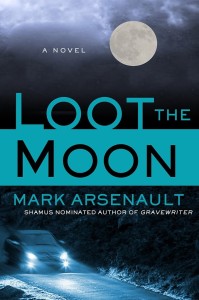Today TKZ is thrilled to welcome author Mark Arsenault, a Shamus nominee and former newsman. Booklist gave his latest release LOOT THE M OON a starred review, describing it as, “a top-notch crime novel.”
OON a starred review, describing it as, “a top-notch crime novel.”
We all remember the newspaper, right? That once ubiquitous part of daily life, now on a fast slide toward an exhibit at the Museum of Obsolescence, where it’ll join the butter churn, the buggy whip, and customer service? (For binary-only types who can’t remember the newspaper, it was like a daily printout of the on-line news. Pretty handy!)
Well, the newspaper still whups the laptop as a fireplace starter and a birdcage liner, and here’s one more—the old fashioned newspaper is the best tool I’ve found for researching historical fiction. For time periods dating as far back as 150 years or so, old newspapers preserved on microfilm beat the Internet as a research tool, and that includes the digitized archives some large newspapers offer on-line. And, no, I have not been hanging around at the polyurethane convention.
When I’m researching a time period for a fictional setting, I might scan old newspaper headlines for factoids, but what I’m really looking for is the advertisements. You can learn a lot about life in another era by what people were buying and selling.
I’ve been researching life on the East coast around 1917 to set a novel. It was a fascinating time period, just 36 years after the gunfight at the O.K. Corral, yet people talked on telephones and drove sporty little cars. How can I be sure? Because I found a great advertisement for the Davis Light Six Roadster, a bargain at $1,095, featuring adjustable seats for “the utmost comfort in motor travel.” For an additional $700, the Hudson Super-Six could top 100 miles-per-hour.
A picture in a bike advertisement shows me that bicycles have barely changed in more than 90 years. I can infer from a dentist’s ad that “pain-free” was a still a selling point in 1917, something we take for granted now.
 I would have guessed that men carried only pocket watches in 1917, but there are also ads for wristwatches with glow-in-the dark “Radiolite” dials. On one old page I recognized a character I’ve known all my life: Mr. Peanut, the tuxedoed nut who peddles for Planters. I had no idea Mr. Peanut was WWI vintage.
I would have guessed that men carried only pocket watches in 1917, but there are also ads for wristwatches with glow-in-the dark “Radiolite” dials. On one old page I recognized a character I’ve known all my life: Mr. Peanut, the tuxedoed nut who peddles for Planters. I had no idea Mr. Peanut was WWI vintage.
Old newspaper ads reveal the attitudes of a culture. Americans in 1917 were modern and naïve at the same time: People played phonograph records back then, went to the movies and drove big Cadillacs. They also paid good money for miracle pills and powders that claimed to cure everything.
Gender roles are obvious in this text from a chewing gum ad: “The high salaried secretary of the big business man knows how important it is to keep her high-strung employer well supplied with Adams Pepsin, the original chicle gum. So she keeps it where he can get it at once without having to ask.”
That pitch probably wouldn’t sell much gum today.
Many libraries keep old newspapers on microfilm. You have to use the microfilm viewer machine, which I call The Vominator because it can make me seasick. But that’s a small price for such a rich resource.
Microfilm may seem too primitive when you can literally download photos from Mars to your phone, but just imagine all those newspages as one big, searchable database. You just search through them one page at a time.
This November’s edition of Ellery Queen’s Mystery Magazine will have a short story of mine set in 1973, a very groovy year. The 70s are my favorite time period for fiction. I love the clothes, the slang, the hair, the cars, the crazy politics. With the Watergate coverage, the 1970s may have been the high-water mark for American newspapers.
Does anyone else have a favorite time period for stories? What makes it your favorite?
Mark Arsenault is a Shamus-nominated mystery writer, journalist, runner, hiker, political junkie and eBay fanatic who collects memorabilia from the 1939 New York World’s Fair. His new novel is LOOT THE MOON, the second book in the Billy Povich series that began with GRAVEWRITER, a noir thriller praised for a fusion of suspense, humor and human tenderness. With 20 years of experience as a print reporter, Arsenault is one of those weird cranks who still prefers to read the news on paper.
